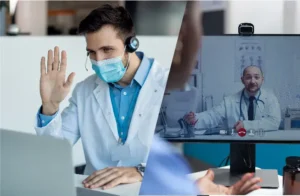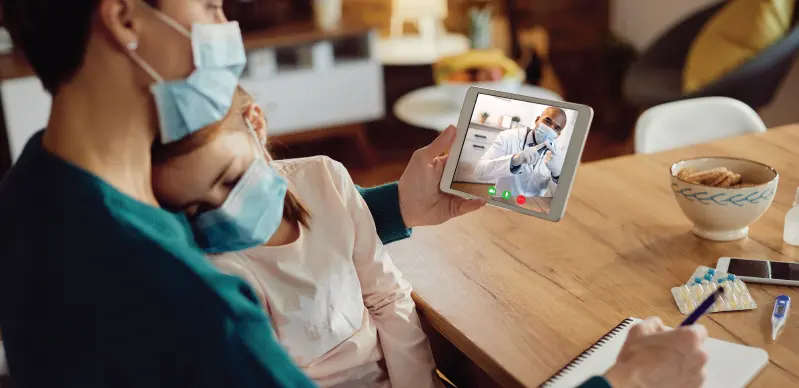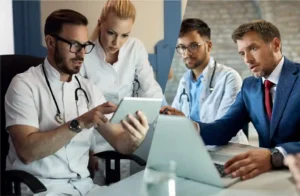
How Telehealth Bridge the Gap in Patient Compliance with Medication?
How Telehealth Bridge the Gap in Patient Compliance with Medication? Did you know that over 50% of patients don’t take their medications as prescribed? This

Remote Patient Monitoring has been transforming healthcare, revolutionizing the patient experience from diagnosis to post-treatment. It permits patients to continuously monitor their health and connect with their medical providers remotely and in real-time. By enabling remote monitoring, healthcare providers have easier access to data that can help inform decisions about diagnosis and treatment.
In this article, we’ll discuss the various benefits of remote patient monitoring and how it is revolutionizing modern healthcare. But before we do that take a look at “What is RPM”?
Remote Patient Monitoring (RPM) is a technology-enabled service that uses digital tools to track the health data of patients remotely. It allows medical practitioners to access specific patient data from anywhere in the world, enabling them to make informed decisions about diagnosis and treatment.
Through RPM, healthcare providers can monitor vital signs such as blood pressure, heart rate, glucose levels, and other biometric information. This data is then used to track patient health status in real time.
Remote Patient Monitoring allows for two-way communication between the patient and their medical provider that can help improve the quality of care and patient experience. It also reduces hospital visits, allowing patients to stay in their own homes while still receiving medical attention from professionals.
Remote patient monitoring (RPM) can help healthcare providers to monitor their patient’s health and well-being from a distance. This type of technology can provide more accurate and timely data, reduce mistakes, and increase efficiency by reducing in-person visits. Additionally, it allows for easy communication between the provider and patient, giving them access to real-time medical data.
RPM enables healthcare providers to monitor vital signs and other medical information remotely, including blood pressure, heart rate, glucose levels, oxygen saturation, and respiration. This data can help healthcare professionals recognize changes in a patient’s condition more quickly and provide timely intervention when necessary.
RPM also allows for the collection of detailed medical histories that are easily accessible in case of emergencies.
Remote Patient Monitoring offers a multitude of benefits that can help healthcare providers and patients alike. Here are some major benefits of remote patient monitoring for doctors:

RPM aids in improving patient outcomes by ensuring that the medical provider can monitor vital signs and other health data in real time. This helps medical practitioners to stay informed about changes in patients’ conditions, which can help them provide timely interventions and treatments for any issues that arise. It also reduces the chance of readmission to the hospital for patients being treated for chronic diseases.
Remote Patient Monitoring can significantly reduce healthcare costs by eliminating in-person visits and reducing the need for hospitalizations, thereby saving both time and money. The cost savings also extend to medical practitioners as RPM allows them to access patient data without having to visit the patient physically.
Remote Patient Monitoring enhances the patient experience by offering convenience and comfort to patients. It allows them to access medical care from their own homes without having to travel for in-person visits. RPM also facilitates better communication between medical practitioners and their patients, which contributes to a more personalized care plan based on individual needs.
By freeing up medical resources, Remote Patient Monitoring allows healthcare providers to focus on providing more personalized care for each patient. By reducing the burden of in-person visits and hospitalizations, RPM provides practitioners with additional time to spend on their patients’ needs. This results in better overall care and improved patient outcomes.
Through Remote Patient Monitoring, healthcare providers are able to better coordinate care by monitoring patient data in real time. This allows them to respond quickly to changes in the patient’s condition and adjust their treatments accordingly.
RPM also allows for better communication between medical practitioners and other healthcare team members, such as nurses or specialists, helping ensure that the patient receives comprehensive care.
Remote Patient Monitoring gives healthcare providers access to real-time data that can be used to make informed decisions about diagnosis and treatment. This allows medical practitioners to quickly respond to changes in the patient’s condition and intervene before any complications arise.
RPM also enables practitioners to compare data over time, allowing them to track trends in the patient’s health and better assess the effectiveness of treatments.
Remote patient monitoring (RPM) is a process of collecting medical data from individuals in one location and sending it electronically to healthcare providers in another location. RPM can help improve the overall quality of care by providing up-to-date information on the condition of an individual, as well as allowing doctors to remotely monitor chronic conditions such as diabetes, hypertension, and heart disease.
RPM is becoming increasingly popular among healthcare providers, patients, and insurance companies due to its ability to improve patient outcomes and reduce costs associated with inpatient hospital stays.
By using RPM, healthcare providers can provide patients with a higher quality of care while decreasing the time needed for diagnosis and treatment.
Additionally, because RPM allows doctors to remotely monitor chronic conditions such as diabetes, hypertension, and heart disease, it can help reduce the number of emergency room visits and hospital stays associated with these conditions.
Overall, RPM is a great tool for improving patient outcomes and reducing healthcare spending. It provides an easy way to monitor patients remotely while simultaneously improving access to care and increasing efficiency. With RPM, healthcare providers can provide patients with better quality care at a lower cost.
Remote patient monitoring is a promising technology that can help improve care quality while reducing healthcare spending. By utilizing RPM, healthcare providers can provide patients with better access to care, improved outcomes, and lower costs associated with inpatient hospital stays. As more healthcare providers continue to adopt this technology, it will become increasingly important for patients to understand the benefits of remote patient monitoring and how it can help improve their overall health. With RPM, patients can enjoy better access to care, improved outcomes, and increased efficiency in diagnosis and treatment.

How Telehealth Bridge the Gap in Patient Compliance with Medication? Did you know that over 50% of patients don’t take their medications as prescribed? This

When billing for chronic care management services, it is crucial to know which Chronic Care Management CPT codes are appropriate to use. CMS unbundled CCM
Talk to an Expert Now